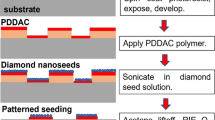Abstract
Although atomic stick–slip friction has been extensively studied since its first demonstration on graphite, the physical understanding of this dissipation-dominated phenomenon is still very limited. In this work, we perform molecular dynamics (MD) simulations to study the frictional behavior of a diamond tip sliding over a graphite surface. In contrast to the common wisdom, our MD results suggest that the energy barrier associated lateral sliding (known as energy corrugation) comes not only from interaction between the tip and the top layer of graphite but also from interactions among the deformed atomic layers of graphite. Due to the competition of these two subentries, friction on graphite can be tuned by controlling the relative adhesion of different interfaces. For relatively low tip-graphite adhesion, friction behaves normally and increases with increasing normal load. However, for relatively high tip-graphite adhesion, friction increases unusually with decreasing normal load leading to an effectively negative coefficient of friction, which is consistent with the recent experimental observations on chemically modified graphite. Our results provide a new insight into the physical origins of energy corrugation in atomic scale friction.






Similar content being viewed by others
References
Mate, C.M., Mcclelland, G.M., Erlandsson, R., et al.: Atomic-scale friction of a Tungsten tip on a graphite surface. Phys. Rev. Lett. 59, 1942–1946 (1987)
Carpick, R.W., Salmeron, M.: Scratching the surface: fundamental investigations of tribology with atomic force microscopy. Chem. Rev. 97, 1163–1194 (1997)
Mate, C.M.: Tribology on the Small Scale: A Bottom up Approach to Friction, Lubrication, and Wear. Oxford University Press, Oxford (2008)
Prandtl, L.: Ein gedankenmodell zur kinetischen theorie der festen Körper. Z. Math. Mech. 8, 85–106 (1928)
Tomlinson, G.A.: A molecular theory of friction. Philos. Mag. 7, 905–939 (1929)
Dedkov, G.: Experimental and theoretical aspects of the modern nanotribology. Phys. Status Solidi A 179, 3–75 (2000)
Gnecco, E., Bennewitz, R., Gyalog, T., et al.: Friction experiments on the nanometre scale. J. Phys. Condens. Matter 13, R619–R642 (2001)
Braun, O., Naumovets, A.: Nanotribology: Microscopic mechanisms of friction. Surf. Sci. Rep. 60, 79–158 (2006)
Szlufarska, I., Chandross, M., Carpick, R.W.: Recent advances in single-asperity nanotribology. J. Phys. D- Appl. Phys. 41, 123001 (2008)
Sasaki, N., Tsukada, M.: Load dependence of the frictional-force microscopy image pattern of the graphite surface. Phys. Rev. B 57, 3785–3786 (1998)
Fujisawa, S., Yokoyama, K., Sugawara, Y., et al.: Load dependence of sticking-domain distribution in two-dimensional atomic scale friction of NaF (100) surface. Tribol. Lett. 9, 69–72 (2000)
Deng, Z., Smolyanitsky, A., Li, Q., et al.: Adhesion-dependent negative friction coefficient on chemically modified graphite at the nanoscale. Nat. Mater. 11, 1032–1037 (2012)
Smolyanitsky, A., Zhu, S., Deng, Z., et al.: Effects of surface compliance and relaxation on the frictional properties of lamellar materials. RSC Adv. 4, 26721–26728 (2014)
Plimpton, S.: Fast parallel algorithms for short-range molecular dynamics. J. Comput. Phys. 117, 1 (1995)
Tersoff, J.: New empirical approach for the structure and energy of covalent systems. Phys. Rev. B 37, 6991 (1988)
Tersoff, J.: Modeling solid-state chemistry: interatomic potentials for multicomponent systems. Phys. Rev. B 39, 5566 (1989)
Dong, Y., Li, Q., Martini, A.: Molecular dynamics simulation of atomic friction: a review and guide. J. Vac. Sci. Technol. A 31, 030801 (2013)
Ye, Z., Tang, C., Dong, Y., et al.: Role of wrinkle height in friction variation with number of graphene layers. J. Appl. Phys. 112, 116102 (2012)
Neek-Amal, M., Peeters, F.M.: Nanoindentation of a circular sheet of bilayer graphene. Phys. Rev. B 81, 235421 (2010)
Socoliuc, A., Bennewitz, R., Gnecco, E., et al.: Transition from stick–slip to continuous sliding in atomic friction: entering a new regime of ultralow friction. Phys. Rev. Lett. 92, 134301 (2004)
Acknowledgments
Qunyang Li would like to thank the support from the National Natural Science Foundation of China (Grants 11272177, 11422218, 11432008), the National Basic Research Program of China (Grants 2013CB933003, 2013CB934201 and 2015CB351903), the Tsinghua University Initiative Scientific Research Program and the Thousand Young Talents Program of China. Xiao-Yu Sun acknowledges the financial support from China Postdoctoral Science Foundation (Grant 2014M562055). The simulations were performed on the Explorer 100 cluster system of Tsinghua National Laboratory for Information Science and Technology.
Author information
Authors and Affiliations
Corresponding author
Appendix
Appendix
Rights and permissions
About this article
Cite this article
Sun, XY., Qi, YZ., Ouyang, W. et al. Energy corrugation in atomic-scale friction on graphite revisited by molecular dynamics simulations. Acta Mech. Sin. 32, 604–610 (2016). https://doi.org/10.1007/s10409-015-0530-6
Received:
Revised:
Accepted:
Published:
Issue Date:
DOI: https://doi.org/10.1007/s10409-015-0530-6






